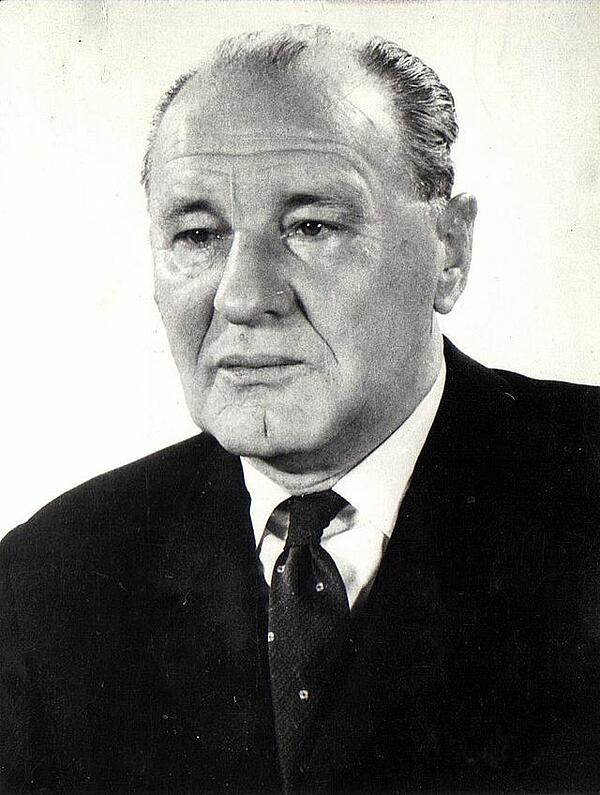Janos Kadar
János Kádár was Hungarian communist leader who took power after the failed Hungarian Uprising of 1956. He ruled Hungary for more than 30 years. As leader, he allowed moderate liberalisation and some freedom of speech, but his role in the crushing of the Uprising and the execution of Imre Nagy remains controversial. In 2007, parts of his body were stolen from Kerepesi Cemetery (Budapest) and a graffiti message proclaiming that ‘Murderers and Traitors Shall Not Rest on Holy Ground 1956 - 2006’ was left nearby. This was a mark of Kádár’s contentious position in Hungary’s recent history.
Born on 26 May 1912 in Fiume, Austro-Hungary, at the age of 15 János Kádár found work as a typewriter mechanic, but was fired during the Great Depression. He joined a trade union and in 1931 he became a member of the Communist Party of Hungary and a member of the Communist Young Workers’ Association. The Communist Party was forced to operated clandestinely: the party had been banned after the fall of the Hungarian Soviet Republic in 1919. In December 1931, Kádár was arrested for spreading communism, but was soon released.
By 1942, Kádár had moved up the party ranks and sat on the Central Committee of the Communist Party. In World War II, Kádár became a leader of the anti-Nazi underground movements. Hungary was fighting alongside Nazi Germany, and most Eastern European party leaders were biding their time in Moscow.
After Hungary was liberated by the the Soviet Union, the nation became governed by Cold War politics. The hierarchy in Moscow handpicked the politicians who ran Hungary and they demanded total loyalty.

Once a communist government was set up in Budapest, Kádár took the position of Minister of the Interior, a position he held from 1948 to 1950. Mátyás Rákosi, the head of the Communist Party, did not trust Kádár. Rákosi tried to purge Kádár along with the Minister of the Interior, Sándor Zöld, and the Minister of Foreign Affairs, Gyula Kállai.
The Hungarian Secret Police arrested Kádár in April 1951 by, then tortured him and kept him in imprisoned in a lone cell at a prison in Vác. A show trial was held and Kádár was charged with being a spy. He was sentenced to life imprisonment. However, he was released in July 1954. It was not until July 1956, when Rákosi left office that he made a political reappearance.
Shortly after Rákosi left office, Kádár was awarded a senior position within the party’s executive. He became General Secretary of the Party on 25 October has an impact on the reforms brought into Hungary during this period. However, things were moved too fast for Kádár. On 1 November, he travelled to Moscow, where the Soviets persuaded him to change sides. He agreed when he was told that the Revolution was going to be crushed. Kádár began to organize a “revolutionary centre" to overthrow the Nagy government with Soviet help. On November 4, he announced the establishment of the "Revolutionary Workers'-Peasants' Government of Hungary".
On the same day, the Soviet army took control of Hungary’s major airports and ordered tanks into Budapest. Houses suspected of harbouring snipers were demolished and as a result of the policy large portions of the city were left in ruins. Budapest, and Hungary as a whole, paid a harsh price for its uprising. More than 200,000 left Hungary as refugees.
When it became clear that the rebellion had failed, Kádár gave Nagy a written note that guaranteed the erstwhile prime minister safe passage. Nagy had gone to the Yugoslav embassy to seek refuge; Kádár’s note tempted him out on 22 November. He was immediately arrested and spirited out of Hungary to Romania. He was later sent back to Hungary and, after a secret trial, hanged in June 1958.
János Kádár became Prime Minister in post-rebellion Hungary. He held this position until 1958. He still had a strong influence on Hungarian politics as General Secretary of the Hungarian Socialist Workers’ Party after giving up his position as prime minister. Kádár served as Prme Minister again from 1961 to 1965.
As General Secretary, Kádár ruled Hungary for more than 30 years. He introduced a series of economic reforms based around cautious liberalism that helped to raise living standards. This system was nicknamed ‘Goulash Communism’.
In May 1988, János Kádár retired and was replaced by Károly Grósz as General Secretary. Kádár died the following year, on 6 July 1989, at the age of 77.
See also:
MLA Citation/Reference
"Janos Kadar". HistoryLearning.com. 2025. Web.
Key facts
| Name: | János Kádár |
| Birth Date: | 26 May 1912, Fiume, Austria-Hungary |
| Death: | 6 July 1989 (aged 77), Budapest, Hungary |
| Spouse: | Mária Tamáska |
| Political Affiliations: |
Hungarian Communist Party
Hungarian Working People's Party Hungarian Socialist Workers' Party |
| Appointments: |
Minister of the Interior of Hungary
August 1948-June 1950 Chairman of the Council of Ministers of the People’s Republic of Hungary November 1956- January 1958 September 1961 – June 1965 General Secretary of the Hungarian Socialist Workers’ Party October 1956-May 1988 |
